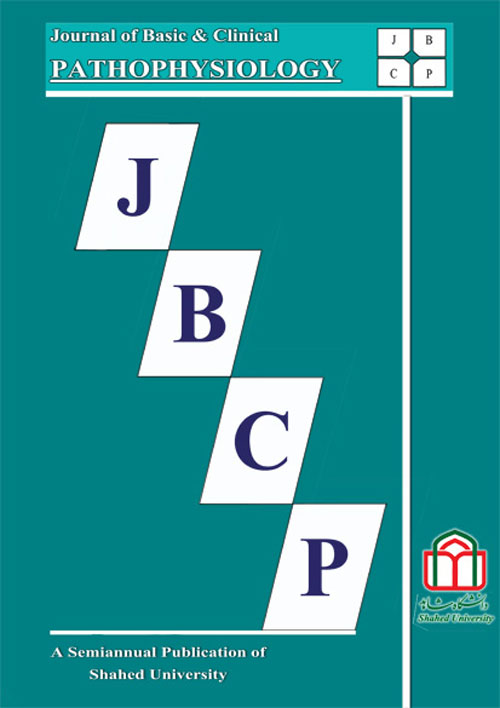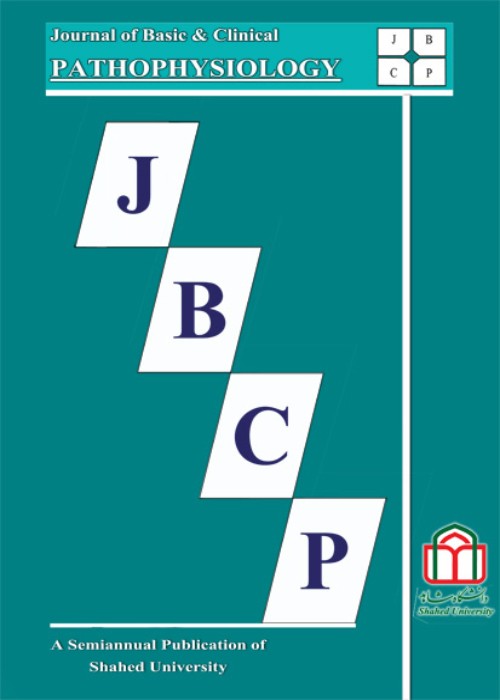فهرست مطالب

Journal of Basic & Clinical Pathophysiology
Volume:3 Issue: 1, Winter-Spring 2015
- تاریخ انتشار: 1394/01/10
- تعداد عناوین: 8
-
-
Pages 1-6Background And ObjectiveThe effect of opioids on the reproductive system has been studied as an attractive research field. In this study, the effect of morphine as an analgesic opioid was evaluated on the ovarian polycystic induction in the rat.Materials and MethodsIn this study, 24 female virgin Wistar rats weighing 200-250 g were injected with morphine (1-10 mg/kg/day) for 9 days. Control group received normal saline (1 ml/kg, i.p.) throughout the experimental period. After completion of injection period, all animals underwent surgery to collect the ovaries. After biometrical measurements, the ovaries specimens were fixed in the formalin to use in future study.ResultsThe ovaries from morphine-injected rats had thick-wall follicular cysts whilst the control samples showed the Graafian follicles. In addition, the higher doses of morphine (10 mg/kg) led to much thicker wall cysts than the lower doses (1 mg/kg). However, the experimental samples did not show a significant difference versus control in view of their size.ConclusionThe enhanced irregularity in the opioid system activity has been reported in polycystic ovary syndrome (PCOS). Based on these findings, the induction of connective disturbance between the opioid and the reproductive systems due to chronic use of the morphine may crucially play a role in ovarian polycystic induction in the rat.Keywords: Morphine, Polycystic, Ovary, Rat
-
Pages 7-12Background and ObjectiveUrinary tract infection (UTI) is a common disease in adults that early diagnosis and proper treatment of it has high importance. This study was performed for analysis of type and antibiotics resistance of isolated bacteria from urine of adult in different sex and ages for help in choose of antibiotics in empirical therapy.MethodData of patients (gender, age, kind of admission and isolated bacteria) with bacterial positive urine culture during three months in 2013 at Pars Hospital, Tehran, Iran, were studied and analyzed by SPSS software. Antimicrobial susceptibility pattern of isolates to cotrimoxazole, ampicillin, ciprofloxacin, gentamicin, amikacin and nitrofurantoin, were also determined by the standard disk diffusion method according to CLSI recommendation.ResultsA total of 1123 urine isolates were collected. Studied patients were often female and outpatients (78.3% and 88.7%, respectively). Escherichia coli was the most common isolate (50%), followed by Streptococcus agalactiae (22.9%), Klebsiella spp. (8.5%), Enterococcus spp. (7.6%), Coagulase Negative Staphylococci (3.7%) and Staphylococcus aureus (2%). Statistically significant differences were seen in distribution of some bacteria regarding demographic characteristics of patients. Highest resistance rates have shown to cotrimoxazole and ampicillin (56.9% and 55%, respectively) among isolated bacteria.ConclusionsThe results show the relationship between demographic characteristics of Iranian patients and type of isolated bacteria from urine and high resistance to common antimicrobial agents.Keywords: Bacteria, patients, urine culture, antibiotic resistance
-
Pages 13-18Background And ObjectiveTemporal lobe epilepsy (TLE) usually leads to memory deficit. In this study, we tried to assess the effect of Withania somnifera extract on the impaired learning and memory in the intrahippocampal kainate model of TLE in the rat.Materials and MethodsMale rats (n=32) were divided into sham, extract+sham, kainite, and kainite+extract. For induction of epilepsy, unilateral hippocampal injection of 1 microgram of kainate was made. Rats received the extract at a dose of 100 mg/kg daily for three days prior to surgery. At the end of 4 weeks, to assess learning and memory, initial latency and step through delay using passive avoidance test and the percentage of alternation behavior in the Y maze test were determined.ResultsExtract pretreatment of kainate group did not significantly attenuate severity and incidence rate of seizures, did not significantly improve retrieval and recall in passive avoidance and significantly ameliorated spatial memory deficit in Y maze (p<0.05).ConclusionThese data suggest that Withania somnifera alcoholic extract could attenuate spatial memory disturbance in TLE model in rat.Keywords: Withania somnifera, Temporal lobe epilepsy, Kainate Learning, memory
-
Pages 19-26Background And ObjectiveVascular endothelial growth factor (VEGF) is a cytokine which is overexpressed in many malignant cancers including leukemia. VEGF plays an important role in tumor invasion and metastasis. Determination of the pattern of VEGF expression in human leukemic cell lines could be useful not only in screening of new antileukemic agents but also to study the mechanism of their action. In the present study, the pattern of VEGF production in some human leukemic cell lines has been assessed in vitro.Materials and MethodsThree human leukemic cell lines (Molt-4, Jurkat and U937) were used in this study. The cells were cultured in complete RPMI medium and then incubated with different concentrations of phorbolmyristate acetate (PMA) or phytoheamagglutinin (PHA) for 48 hours. The level of VEGF secreted in the cellculture supernatants were measured with enzyme-linked immunosorbent assay kits (R and D systems).ResultsU937 cells produced a large amount of VEGF without any stimulus and PHA/PMA did not show any substantial effect on VEGF production by U937 cells. However, Molt-4 and Jurkat cells, produced VEGF less than U937 when cultured alone (with no stimulation) and PMA/PHA significantly increased the VEGF production in these cells dose-dependently.ConclusionDifferent patterns of VEGF expression were shown in different leukemic cell lines (Molt-4, Jurkat and U937) used in this study. These cells could be useful tools for screening of VEGF modulators and so for planning of new drugs for treatment of leukemia and other VEGF related disorders.Keywords: Vascular Endothelial, Growth Factor, Leukemia
-
Pages 27-32Background And ObjectiveCongenital heart disease (CHD) is the most form of cardiovascular disease in children. CHD have different presentations, from defects that progress asymptomatically to those with significant symptoms and high mortality. This study was performed to highlight the importance of signs and symptoms to diagnosis of CHD neonates.Materials and MethodsThis descriptive analytic study was performed on 113 newborns in NICU ward of Mostafa Khomeini hospital from March 2010 to March 2011, referred for cardiac evaluation by echocardiography. Data and echocardiography results were extracted from patients’ documents. PDA in preterm newborns was excluded.ResultsEchocardiographic findings were normal in 20 newborns and abnormal in 93 cases. Murmur and cyanosis were reasons for referral to cardiologist in 45 (39.82%) newborns, of which 42 (93.33%) newborns had CHD. DM in mothers was the reason for referral in 21 (18.85%) newborns, of which 17 (80.95%) newborns had CHD. Asphyxia was the reason for referral in 17 (15.04%) newborns, of which 14 (82.35%) newborns had CHD. Bradycardia was the reason for referral in 13 (11.50%) newborns, of which 11 (84.62%) newborns had CHD. Arrhythmia, associated congenital malformation, chromosome disorders, tachycardia, RDS and CHF were uncommon reasons for referral.ConclusionThe main reasons for referral were heart murmur and cyanosis. Although other reasons were uncommon, their presence indicated a high probability of diagnosis of heart disease.Keywords: Congenital Heart Disease Echocardiography, Murmur, Newborn, NICU
-
Pages 33-38ObjectiveThe present study was designed to investigate the analgesic effect of oral and i.p. administration of alcoholic Viscum album (V.A) fruit extract as a rich source of alkaloid substances.Materials And MethodsExperimented animals were divided into control and treatment groups. The treatment rats received different doses of the V.A fruit extract, which was prepared from alcoholic smashed fruits. Then, the animals from each group were subjected to pain scoring experiments such as hot plate and formalin tests.ResultsThe results of the experiments i.e., antinociceptive effect of i.p. V.A extract (50, 100 and 200 mg/kg) and oral application method V.A (6.25% food pellet) were compared with others and morphine sulfate and naloxone as positive and negative control groups, respectively. The extract at doses over than 100 mg/kg (i.p.) could potentially alleviate the pain in hot plate and both phases of the formalin test. Besides, there was a marked antinociceptive effect of the extract (over than 200 mg/kg) in oral method in hot plate and both phases of the formalin tests. Meanwhile, the effective doses of morphine sulfate as positive control were observed at doses over than 15 mg/kg (i.p.).ConclusionIn summary, by comparing the analgesic effect of different doses of morphine sulfate with V.A fruit extract in i.p and oral conditions and regarding to the extract LD50, it is concluded that the V.A fruit extract has a potent, semi-absorbable, and nearly safe ingredient which can exert a potential analgesic effect in acute and chronic painIn summery, by comparing the analgesic effect of different doses of morphine sulfate with V.a fruit extract in i.p and oral conditions and regarding to the extract LD50, it is concluded that the V.A fruits extract have a potent, semi-absorbable, and nearly safe ingredient which can exert a potential analgesic effect in acute and chronic pain.Keywords: Viscum album, Formalin test, Hot plate, Rat, pain
-
Pages 39-46Background And ObjectiveEpilepsy is a long-lasting central nervous system disorder that is accompany with spontaneous seizures and insufficiency in learning and memory. Now drug treatment is the most common therapy but some patients do not research to suitable control of their seizures with current drugs. Hence, new treatment is needed to help those patients that are unaffected to existing drugs. In present study, we evaluate the protective effect of pretreatment with salvianolic acid B in experimental model of temporal lobe epilepsy in male rats.Materials and MethodsIn the present study, the effect of intraperitoneal administration of salvianolic acid B (10 mg/kg) on induced seizures and learning and memory impairment induced by intrahippocampal injection of kainic acid (KA, 4 mg) were assessed in rats.ResultsObtained data showed that the epileptic rats display kainic acid-induced seizures. On the other hand, in epileptic rats, spontaneous alternation score in Y maze tasks lowered (p<0.001) and retention and recall capability in the passive avoidance test impaired (p<0.05). Treatment of kainate rats with salvianolic acid B decreased the scale of induced seizures (p<0.01), improved alternation score (p<0.005) and retention and recall capability (p<0.01).ConclusionTaken together, this study reveals that treatment of kainate rats with salvianolic acid B could attenuates kainic acid-induced seizures and impairment of short-term spatial memory in rats.Keywords: Kainic acid, Salvianolic acid B, Passive avoidance, Y maze, Seizure, Rat
-
Pages 47-50Background And ObjectivesCoronary artery disease (CAD) is regarded as the leading cause of morbidity and mortality around the world. Diabetes mellitus (DM) is associated with the development of CAD and increased risk of morbidity and mortality. The goal of this study was to assess the association of tumor necrosis factorα (TNF-α) and high sensitivity C-reactive protein (hsCRP) with CAD severity in diabetic patients.Materials and MethodsThe cross-sectional protocol of this research was conducted on the referrals (n=81) of Chamran and Alzahra hospitals (Isfahan, Iran) in 2012. The severity of CAD was determined using angiographic findings and Gensini scoring system. TNF-α and hsCRP were measured in addition to some routine parameters. For statistical analysis, Chi-square test was used.ResultsOf the patients, 57 were male (70.3%) and 24 (29.6%) were female with a mean age of 54.2 years. In addition, a significant relationship was found out between the severity of CAD and level of hsCRP and TNFa (p<0.05-0.01).ConclusionMarkers of inflammatory mediators like hsCRP and TNFa are strongly associated with CAD in diabetic patients that have clinically high prognostic value.Keywords: Diabetes mellitus, Coronary artery disease, High sensitivity C, reactive protein, Tumor necrosis factor Inflammation


